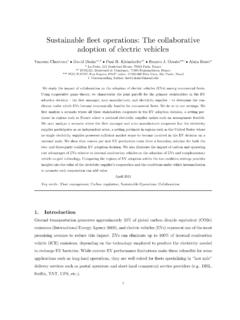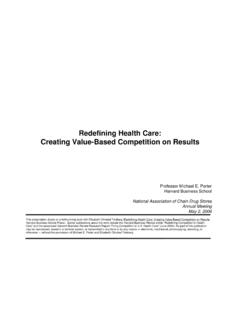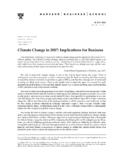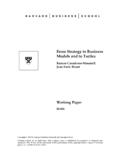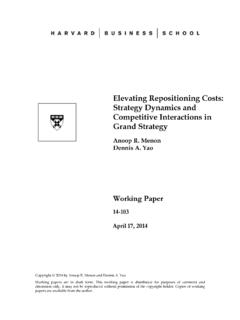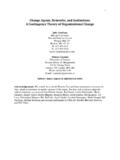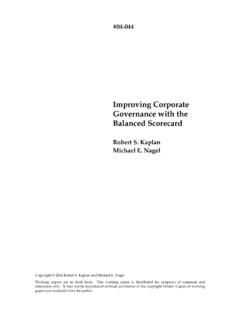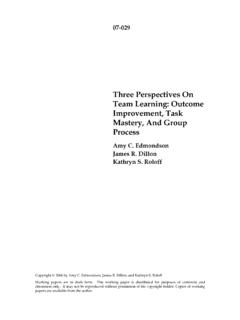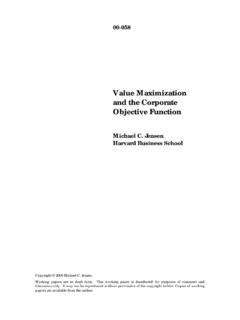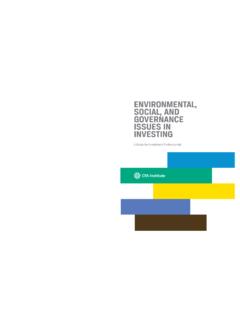Transcription of Measuring the “impact” - Harvard Business School
1 Measuring the impact in impact investingIvy So & Alina StaskeviciusMBA 2015 Harvard Business SchoolFaculty Supervisor: Alnoor Ebrahim2015 This report was developed as part of an independent project through the Harvard Business School Social Enterprise Initia-tive in fall 2014, under the supervision of Alnoor Ebrahim. We welcome comments, feedback, and thoughts on this report. Please feel free to contact us: Ivy So and/or Alina Staskevicius of ContentsList of Figures 4 Executive Summary 51. Context 112. Definitions and Scope 123. Objectives Behind Impact Measurement 144. Understanding Current Methodologies Expected Return Theory of Change and Logic Model Mission Alignment Methods Experimental and Quasi-Experimental Methods 405. Cross-Cutting Themes Incentives Additionality 536. Putting It Together: Integrated Approach to Impact Management 557.
2 Conclusion 57 List of FiguresFigure Continuous Cycle of Measurement Objectives Figure Map of Measurement Methodologies to Measurement Objectives Figure Summary of Measurement Method AnalysisFigure Integrated Model of Impact MeasurementFigure Organizations InterviewedFigure Continuous Cycle of Measurement ObjectivesFigure Map of Measurement Methodologies to Measurement ObjectivesFigure Steps in SROI processFigure Excerpt of SROI Calculations from REDF ReportFigure Logic Model FrameworkFigure Contingency Framework for Measuring Social PerformanceFigure Acumen s Theory of Change ModelFigure LGTVP s Logic Model for MFK investmentFigure Link Between Balanced Scorecard and Logic ModelFigure Dimensions of Acumen s Impact PhilosophyFigure Bridges Ventures IMPACT RadarFigure Sample Investor-Level Scorecard Template and Hypothetical Portfolio-Level Scorecard AggregationFigure Examples of Quasi-Experimental MethodsFigure Screenshot of Smallholder Impact Literature WikiFigure Integrated Model of Impact Measurement5measuring the impact in impact investingExecutive SummaryIntroductionThe growth of impact investing has led to an unprece-dented focus on impact measurement, with the aim of understanding both financial and social return on these investments.
3 However, impact measurement is com-plex in practice, and varies in approach and rigor, with a number of methodologies and practices emerging from different organizations. This carries a risk for the emerging field of impact investing ; if a certain level of rigor in impact measurement is not established across the industry, the label impact investing runs the risk of becoming diluted and used merely as a marketing tool for commercial aim of this study was to deepen the understanding of the specific practices and methodologies that estab-lished impact investors are using to measure the social impact generated by their investments, and to analyze the conditions under which each measurement method is most relevant. The intended audience for our analysis is impact investors themselves, as well as social sector organizations, traditional funders, and a part of our research, we conducted over 20 inter-views with practitioners across a wide range of domes-tic and international organizations in the private, social, and public sectors.
4 Recognizing that the nascent impact investing field may benefit from examining the practices used by more traditional funders, our interviews also in-cluded foundations, venture philanthropists, and other relevant organizations. A full list of our interviews can be found in Appendix these interviews and review of relevant reports and literature, we gathered information on the methods currently used by impact investors and other funders. We synthesized these findings to identify common ob-jectives behind impact measurement and to develop categories of measurement methods. We analyzed the advantages and disadvantages of each category and de-veloped recommendations for effective adoption as well as advancement for the sector. We also developed recom-mendations for two cross cutting themes incentives and additionality.
5 Finally, we recommend an integrated model of impact measurement that provides a compre-hensive approach throughout the investment life cycle. Findings and AnalysisImpact measurement efforts serve a number of different objectives throughout the investment cycle. We found that measurement efforts can be logically grouped into four key measurement objectives:1. Estimating impact: Conducting due diligence pre-investment 2. Planning impact: Deriving metrics and data collection methods to monitor impact 3. Monitoring impact: Measuring and analyzing impact to ensure mission alignment and performance 4. Evaluating impact: Understanding post-investment social impact of an intervention or investment These objectives feed into one another, as described below: In addition to the four objectives mentioned above, im-pact measurement can also be used to report impact and communicate with various audiences.
6 1 Estimating Impactfor due diligence2 Planning Impactthrough strategy3 Monitoring Impactto improve program4 Evaluating Impactto prove social valueFigure Continuous Cycle of Measurement Objectives6measuring the impact in impact investingImpact investors employ a number of methods to pur-sue the objectives outlined above. By identifying pat-terns that we found in our research, we have categorized four impact measurement methods: 1. Expected return takes into account the anticipated social benefits of an investment against its costs, dis-counted to the value of today s value. This expected re-turn metric can take various forms; examples include Social Return on Investment (SROI), Benefit Cost Ra-tio (BCR), and Economic Rate of Return (ERR).2. Theory of change and logic model explain the process of intended social impact. Specifically, logic model is a common tool used to map a theory of change of an organization, intervention, or program by outlining the linkage from input, to activities, to output, to out-comes, and ultimately to impact.
7 3. Mission alignment methods measure the execution of strategy against mission and end goals over time; examples include social value criteria and scorecards used to monitor and manage key performance Experimental & quasi-experimental methods are after-the-fact evaluations that use a randomized control trial or other counterfactual to determine the impact of the intervention compared to the status quo. Impact measurement methods generally serve specific objectives in the investment cycle. Mapping the methods against the objectives provides a view of how each of these methods can accomplish the different objectives. The fol-lowing graphic illustrates how such methods have been applied to the various phases of impact measurement. Figure Map of Measurement Methodologies to Measurement Objectives1 Estimating Impactfor due diligence2 Planning Impactthrough strategy3 Monitoring Impactto improve program4 Evaluating Impactto prove social valueExpected Return SROIT heory of Change Logic ModelMission Alignment Methods Social Value Criteria ScorecardsQuasi-Experimental & Experimental Methods RCT Historical baseline Pre/post test Regression discontinuity design Difference in differencesInvestment Process Alignment:Due DiligencePre-ApprovalPost-Investment7mea suring the impact in impact investingEach measurement method carries advantages and dis-advantages.
8 An overview of this analysis is included in the table Summary of Measurement Method AnalysisMethodCommon applicationsAdvantagesDisadvantagesExpec ted Return To estimate expected social return in assessing potential investments To monitor and evaluate the social performance of investments Can provide a disciplined approach for decision making Offers opportunity for orga-nization to speak a common language Similarity with return on investment can help gain private sector trust May unfairly penalize in-terventions working with the most challenging problems and populations Can be perceived as inexact and constantly changing Expected return calculations are only as strong as the data that feeds them Risk of temptation in using expected return figure as standalone metric for funding decisions Not applicable to interven-tions without quantifiable benefits Does not take into account catalytic effectsTheory of change and logic model To understand path to in-tended impact as part of due diligence To provide a framework for goal setting To track and monitor prog-ress of investment To provide targets for incen-tive schemes To provide a framework for illustrating impact logic in reporting Provides an easy to un-derstand framework that is familiar in the social sector Is a versatile tool that can serve multiple purposes Allows investors to overlay dimensions that are import-ant to mission Allows investors to identify underlying impact assump-tions for further review as necessary Identifying indicators to assess outcomes can be challenging Lends itself to risk of reduc-ing social change to a linear processMission align-ment methods To monitor impact investor s
9 Portfolio against its mission To monitor impact of invest-ee against its mission Surveys and screens are inexpensive, straightforward ways to monitor mission alignment Scorecards may resonate with investors due to familiar-ity with balanced scorecard in Business Survey results or scorecards are only as meaningful as the data collection methods or KPI metrics that they capture Scorecards may not allow for direct comparisons across different investments8measuring the impact in impact investingMethodCommon applicationsAdvantagesDisadvantagesExper imental & quasi-experimen-tal methods To assess outcome for pay-ments in Social Impact Bonds and other impact investments To test hypothesis of an investor s theory of change To assess impact risk of a potential investment Experimental methods allow for robust cause-and-effect attribution Quasi-experimental methods can provide some attribution evidence with more flexibility and lowest cost Both of these methods
10 Can help to demonstrate addition-ality of impact Experimental methods can be expensive and resource intensive Experimental methods not suitable in many situations, environments that cannot be controlled, interventions that are insufficient to drive outcomes on their own, situations where randomizing beneficiaries may be unethical Quasi-experimental methods may be limited in their ability to rule out exogenous factorsFigure , continued Summary of Measurement Method AnalysisAdditional Findings While impact measurement offers benefits for multiple stakeholders in an impact investment, there is a need for greater alignment for incentives to devote resources to Measuring impact. Factors that contribute to low incen-tive to measure impact include: Perception of low value in impact measurement by entrepreneur Survey fatigue of beneficiaries Low fund investor appetite for robust measurement Limited incentive structures for delivery of social impactWe believe that addressing these factors are critical in making progress in Measuring impact in this is an important consideration in thinking about impact.
